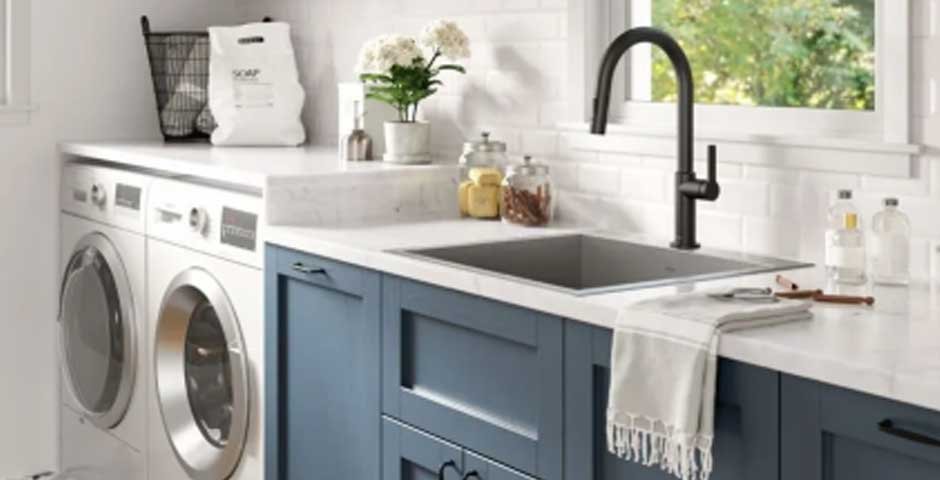Suppose the house doesn’t have a separate laundry room. You can remodel a corner to buy a stainless laundry sink or utility sink for the kitchen. This practical feature is necessary to make your regular chores easy. There can be many more examples of such modern needs. However, let’s focus on the structural aspects that older homes proudly flaunt and are rare or impossible to find in a newly constructed apartment. For instance, it can be a phone niche typical of ancient times when technology and people operated differently. Or, think of the older staircase’s details and style. There is a lot of drama and creativity packed into one thing. Hence, it can be interesting to delve into this specific trait.
Style – witches’ stairs
In 2021, viral TikTok video content grossed 15 million views for discovering a quirky-looking staircase design, such as witches’ stairs. Also called alternate-tread stairs or ship ladders, the main highlight of this style is the steep slope and irregular treads. A regular staircase contains the same-size steps, but this one can be narrower. People relied on it for its space-saving nature. Many northeastern American homes may still have this. Because of the steep treads, the stairs take little space and suits a house with a smaller footprint. You may be curious about the spooky moniker used for a naïve structure like this. Some funny stories suggest that these stairs were difficult for witches to climb. Hence, people built them in their houses. There are many more variations of the narrative that don’t have any credibility factually but make for everyone’s entertainment.
For the unaware, the style was simply famous as Jefferson stairs or alternate-tread stairs before gaining a new name. As hinted, the purpose of this design was to save space. It replaced the ladder in the house’s attics and lofts, where a full-size staircase design was challenging to include. Many commercial spaces may also have this style in their cellars, storage areas, and lofts. If your house has this feature, you can use the underneath space to fashion it into a storage area. Small closets and pull-out drawers can easily fit into the quirky steps, eliminating unnecessary wastage of space.
Fascinated by its characteristic shape, you may ask whether you can build it in your new home. Experts explain that modern staircases follow safety standards, considering steepness, railings, height, and depth. The steep design of the witch’s stairs is a little off the requirements of the latest building codes. That’s why it’s rare to find it in new construction. If some areas allow this, they look into specific conditions before approving.
Other older staircase features
Back then, vacuum cleaners and other advanced household tools were uncommon or inaccessible. But people found ways to solve their everyday concerns. For instance, stair corners easily collect dust and grime. Without vacuum cleaners, one can imagine how difficult this job can be. So, households used dust guards to sweep it comfortably. The tool came on the market in the 1890s. Apart from this practical purpose, the dust guards enhanced the charm of the wooden staircases. You can use this tool in the section between the fireplace molding and the wall.
Another exciting discovery in a Victorian theme can be stair rods that helped runner carpets to stay in their place on the wooden staircases. In those days, this feature had aesthetic and functional importance. Nowadays, stair rods serve only looks because people use stapling techniques to fix their carpets. Like these, you can also focus on balusters or spindles that support the staircase with handrails. Older buildings added one baluster upside-down due to superstition. Some believed this intentional installation design denotes that only the Almighty can create perfect things, while others attached it to shooing away the devil. Regardless, it has primarily mystical connotations.
The DIY stuff
After learning about these old house features, you can feel proud of their attributes and desire to preserve them. While handing over structural damages to professionals is best, you can handle the surface-related details. Does your house have a staircase with one spindle facing down, breaking the pattern? You can be excited to spot this, but its faded paint can be your concern. You can get rid of this without hurting your savings much. Just get your latex gloves, socks, paint color, etc.
Open the box of the paint and mix it well. Before this, cover the area on and around the staircase with a plastic sheet. Wear your socks in your hands over the latex glove to color the spindles. Dunk the hand covered in the layers of latex gloves and socks in the bucket to take paint to apply on the targeted area. You can work with mini rollers in the tricky corners of the spindles for easy paint application. You can use an old clothing piece or rag for the spindles if you don’t have socks. While coloring the baluster, you should check the amount of paint you pick in the fabric. Also, protecting nearby furniture and surface from dripping paint is essential.
Whether it’s a new or old house, some of its features can be dear to you, and you can be willing to do everything to preserve them. Adding a utility sink in the old kitchen or storage space under the witch’s stairs exemplifies this. You can introduce a few other elements to increase your home’s utility and aesthetic. When you take these steps, you make the most of your living space, greatly enhancing the quality of your daily life. Isn’t this a wonderful feeling?






